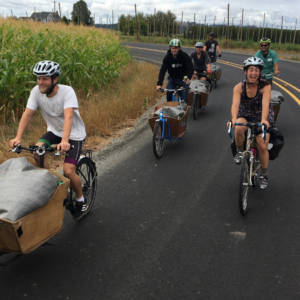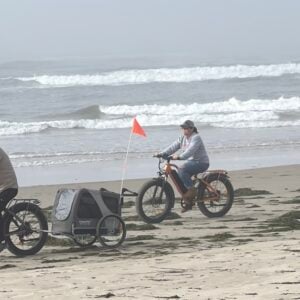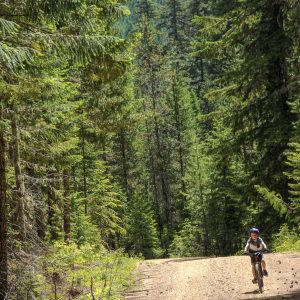I don’t have the complete breakdown of traffic crash and fatality stats for 2006 yet, but from what I’ve gleaned so far the numbers show an encouraging downward trend.
Here are some factoids to think about:
- There were zero bike fatalities in 2006. That’s down from four in 2005.
- There were 28 total traffic fatalities in 2006, down from 33 in 2005, and 47 for 2003.
- The Traffic Division made 1,524 DUII arrests in 2006 compared with 1,244 in 2005.
- The Traffic Divsion investigated 1,629 collisions (both bike and car) in 2006 compared with 738 in 2005.
On a similar note, the map below shows a clear drop in bicycle crashes in relation to increased bike traffic. It only has numbers up to 2005, but the trend continued in 2006:
I realize stats don’t always tell the entire story and that fatalities often have much to do with fate. Even so, I also know there’s a lot of work being done to make Portland’s streets safer for everyone and it’s encouraging to see a downward trend in these numbers.
Everyone involved in the all-important “four E’s” of education, engineering, encouragement and enforcement deserve a lot of credit for this.
Let’s hope 2007 continues the trend.







Thanks for reading.
BikePortland has served this community with independent community journalism since 2005. We rely on subscriptions from readers like you to survive. Your financial support is vital in keeping this valuable resource alive and well.
Please subscribe today to strengthen and expand our work.
I am confused. I read about the couple who were killed in the western part of Portland last summer, there was the big issue of the cyclist who was killed in downtown Beaverton, and I believe there was one other cyclist who was killed in Portland proper. How can the city say that no cyclists were killed in 06?
Aaron:
Hope this helps. Beaverton is not Portland. Hillsboro is not Portland. Esticada is not Portland. Portland is Portland.
I was surprised by the good news too. I googled it, then searched around and it looks like there were zero bike deaths in Portland in 2006. Can you find a single news story about a person being killed on their bike in 2006 in Portland not in a suburb or rural area outside of Portland? I couldn’t.
Maybe Beaverton and Hillsboro and other cities that had too many people killed on their bike could learn a thing or two? That “Combined Traffic…” diagram Jonathan made in his post up there shows that something good is happening in PORTLAND.
Slick
The discrepancy between fatalities within the city limits vs. outlying areas supports my feeling that the biggest safety threat facing cyclists are rural roads.
I have written about it before and it will continue to be a major problem until we take aggressive steps to change something.
I feel that many cyclists have a false sense of security on rural roads (some are often too afraid to ride “in the city”). This combined with very high speeds and very few traffic control devices makes this a recipe for disaster.
The solutions seem obvious to me (discourage speeding, wider shoulders, educate all users, etc…), but it will take more deaths for politicians to make this a major priority (kudos to DeFazio who already seems to be thinking about it).
Jonathan,
Rural and suburban roads also breed a different kind of rider. These riders (myself included) are more aggressive and ride at higher speeds. We also enjoy, in my opinion, much better bike lanes, longer stretches between stops and less on-street parking in the ‘burbs and that encourages a faster brand of riding than urban PDX riding. While I agree that driver and infrastructure improvement is still needed in these areas, the comparisons to city commuters is apples-and-oranges.
This also illustrates the schism seen so often on this site. Different riders, different mindsets, different needs. While I respect what city commuters lobby for, suburban riders and recreational cyclists also have needs and we are somewhat leery of Portland-centric solutions and Portland-centric advocacy as it tends to dominate the bike landscape and the flow of bike dollars from Salem and Washington D.C. Admittedly, I have trouble comprehending the “danger” of sharing a mixed use lane with peds on a bridge at 10-12 MPH or riding amongst slower moving traffic with many calming devices (lights, signs, traffic circles, speed bumps) when my danger is a 40 MPH descent on NW Cornell (no shoulders or bike lanes) amongst higher speed car traffic during both rush hours. To my way of thinking, riding in town seems like an annoyance as opposed to mortal danger. So I have trouble thinking that “bike boulevards”, Dutch-style seperated lanes, etc. are a funding priority as opposed to higher speed, safer, and more efficient corridors from the ‘burbs and neighborhoods more than 50-60 blocks from downtown (especially on the hilly Westside). That is where the car commuters come from and don’t see cycling as a viable alternative.
(Note to Dabby – Messengers are another game entirely so don’t think that I group your profession / needs in with those of the average bike commuter)
Brad,
These are great points. I didn’t intend my comment as an insult to suburban/recreational riders. I am one myself and I’ve spent a lot of time in the saddle out there.
In answer to some of your points about advocacy and where money is spent…
The way I see it is advocacy happens (and as a result money is spent) where there are the most vocal advocates and highest number of users.
I don’t think it’s constructive to debate the potential for danger between various paths and roadway types. We are vulnerable users and serious injury can happen at a wide range of speeds.
It comes down to City boundaries as well. I’m not sure if any of those rural roads are in Portland city limits.
Beyond boundaries, it’s all about being vocal and showing up to the table to describe your issues, offer solutions to fix it, be willing to do the work, and most importantly, demand that your elected officials and/or the advocacy organizations you are a member of are putting adequate effort into your concerns.
“Portland-centric” solutions and advocacy dominates because we have a lot of energy around various issues and we are highly involved with the process from the grassroots to City Hall.
There is always more advocacy work to be done…perhaps this issues is a good catalyst to organize a new BTA chapter in Washington County?
I too have wondered about the chasm in the riding experience between riding in Portland and its surrounding ‘burbs. As this BikePortland site reports so well, Portland has world-class support for cycling.
In response to Brad’s comments: What one rider considers “annoying” urban riding, I consider safe. As a former racer and former suburbanite, I now prefer the environment where I take the lane and cars (going 25mph at the most) are forced to respect me. The suburban ride, although allowing for longer stretches without stopping, presents a white line painted on the ground to separate me between inattentive drivers doing 50mph.
In the end, to each his own. If living in suburbia makes you happy, then so be it. But don’t pretend that your commute is imposed upon by some external force. It’s your choice where you live and work, whether you believe it or not. I choose to live in Portland partly because of the fact that it supports cycling so well. Unfortunately, many suburban areas are simply not built to support cycling. Suburbs are almost inconvenient by definition; they are often designed to be traversed only by car.
I could go on about this ad nauseum, but in the end, I’m with Jonathan in supporting some efforts to make rural riding safer. I live in the city, but I love the fact that within 20 minutes of riding I can be in another world. I haven’t raced in a while but I still love a long ride!
I only do long distance road rides in norcal with others during times that there is little or no car traffic. one of my friends will never be the same because of a head on collision while he was biking that never should have happened. either way, be safe out there on 26, it is extremely dangerous.
As an everday cyclists(no car since 04), I just want cops to leave me alone and for cars to slow down and maybe even consider treating me like I have a right to be there. Getting from point A to point B safely and efficiently is really all I care about. I respect all cycle freaks, spandex warriors, messengers, old ladies who ride tricycles to the grocer, all of them.
here is to a fatality free 07. hell, that should be a goal for the city bike folks…